Mohiniyattam: Embracing Tradition, Embodying Grace
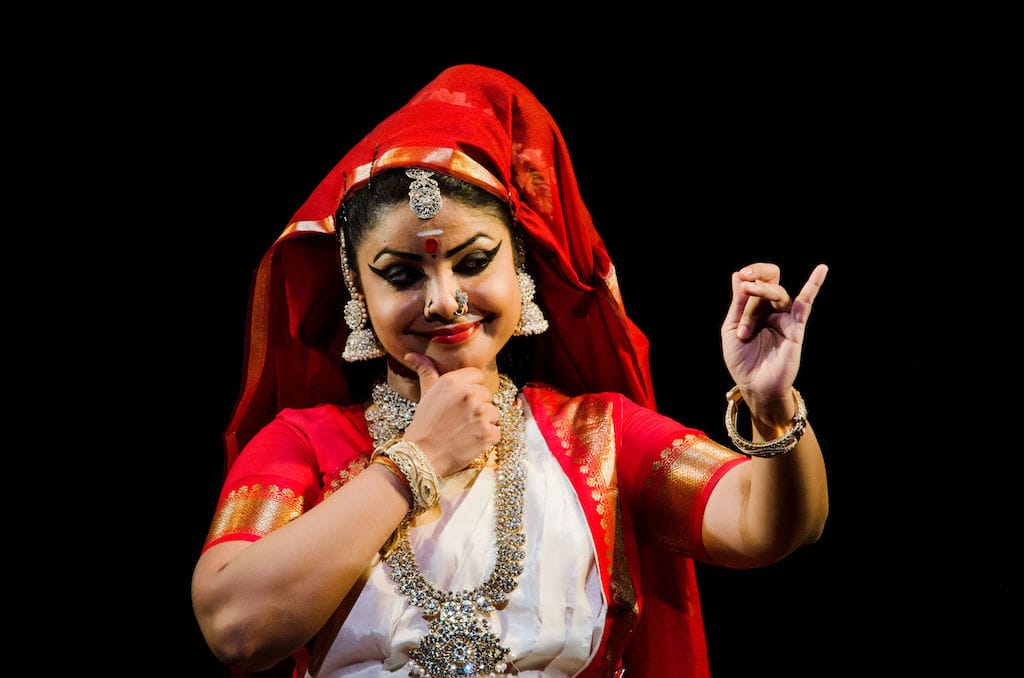
Mohiniyattam, a captivating classical dance form, finds its origins deeply rooted in Hindu mythology. At the heart of its narrative lies the story of Mohini, the mesmerizing female avatar of Lord Vishnu, the preserver in Hindu cosmology. According to ancient texts and legends, Mohini emerges during a celestial battle between the Devas (celestial beings) and the Asuras (demons). Armed with her feminine allure and enchanting charm, Mohini aids the Devas in securing victory over the Asuras, showcasing the power of divine grace and beauty in overcoming adversity.
Etymology and Symbolism
The name “Mohiniyattam” is a fusion of two distinct components: “Mohini,” representing the divine enchantress, and “aattam,” denoting rhythmic movement or dance in the Malayalam language. Together, these elements encapsulate the essence of the dance form as a graceful and alluring expression of artistic beauty. Mohiniyattam, therefore, symbolizes not only the divine feminine energy embodied by Mohini but also the intricate interplay of rhythm, movement, and storytelling inherent in classical dance.
Ancient Roots and Temple Traditions
The origins of Mohiniyattam can be traced back to the rich cultural heritage of Kerala, where temple traditions and rituals provided fertile ground for the development of various art forms. References to dance and performance arts in Kerala can be found in ancient texts and temple sculptures, suggesting a deep-seated tradition of artistic expression dating back centuries. Mohiniyattam, with its graceful movements and emotive storytelling, likely emerged from this vibrant cultural milieu, drawing inspiration from classical texts such as the Natya Shastra.
Emergence as a Recognizable Form
While the precise historical timeline of Mohiniyattam’s development remains elusive, textual references and archaeological evidence offer glimpses into its early evolution. The 16th-century legal text Vyavaharamala contains one of the earliest mentions of the term “Mohiniyattam,” indicating its presence in Kerala’s social and artistic landscape during that period. Additionally, temple sculptures depicting female dancers in poses reminiscent of Mohiniyattam suggest that the dance form had already begun to take shape by the medieval era.
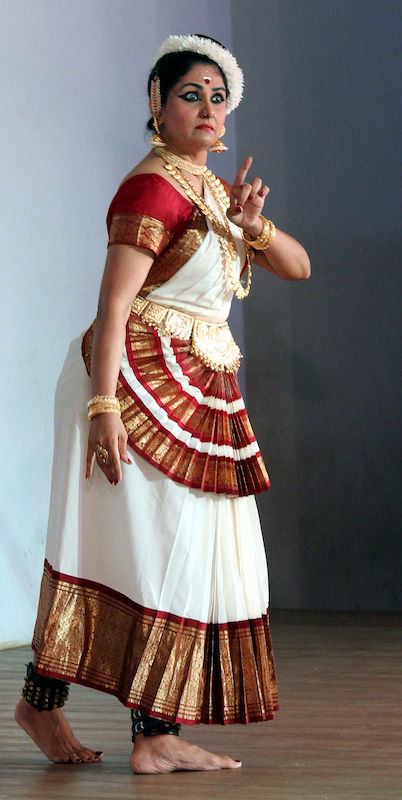
Patronage and Renaissance
Mohiniyattam experienced periods of growth and refinement under the patronage of princely states and royal courts in Kerala. Particularly noteworthy was the support extended by Swathi Thirunal Rama Varma, a renowned composer and patron of the arts, who played a pivotal role in elevating Mohiniyattam to greater prominence. His efforts to foster collaboration between Mohiniyattam and Bharatanatyam artists contributed to the systematic development of the dance form and its repertoire.
Colonial Encounters and Revival Efforts
The colonial era posed significant challenges to Mohiniyattam and other classical dance forms in India. British colonial policies and missionary activities led to the stigmatization and suppression of indigenous cultural practices, including temple dances like Mohiniyattam. The anti-dance movement of the late 19th and early 20th centuries further marginalized traditional performers and disrupted the continuity of dance traditions.
Despite these obstacles, Mohiniyattam experienced a revival and resurgence in the early 20th century, fueled by nationalist sentiments and efforts to reclaim India’s cultural heritage. Visionaries such as Vallathol Narayana Menon played a crucial role in reviving Mohiniyattam by establishing institutions like Kerala Kalamandalam and advocating for its recognition as a legitimate art form.
Lasya Style and Feminine Grace
Mohiniyattam is characterized by its embodiment of the Lasya style, as described in the Natya Shastra. Lasya represents the gentle, graceful, and feminine aspects of dance, emphasizing subtlety, elegance, and emotional expression. In Mohiniyattam, dancers strive to convey a sense of delicate beauty and nuanced emotions through their movements, gestures, and facial expressions. This emphasis on Lasya distinguishes Mohiniyattam from the more vigorous and masculine Tandava style, highlighting its unique aesthetic sensibilities.
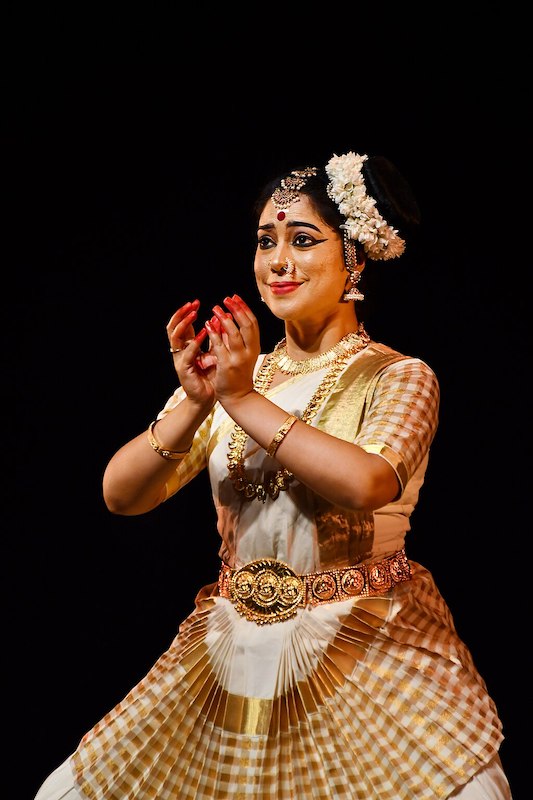
Ekaharya Abhinaya and Solo Expression
At the heart of Mohiniyattam lies Ekaharya Abhinaya, a solo expressive dance form that integrates singing, music, and storytelling. Dancers engage in intricate hand gestures, known as mudras, to convey emotions, depict characters, and narrate narratives. Through subtle shifts in posture, facial expressions, and eye movements, they evoke a wide range of sentiments, from love and longing to devotion and sorrow. This solo expression allows dancers to establish a direct connection with the audience, drawing them into the captivating world of Mohiniyattam.
Rhythmic Complexity and Musicality
Mohiniyattam is closely intertwined with Carnatic music, with dancers performing to compositions in the Carnatic style. The dance sequences are intricately synchronized with the rhythmic patterns of the music, creating a seamless fusion of movement and melody. Percussion instruments such as the Mridangam, Idakka, and Kuzhitalam accompany the dance, adding layers of rhythm and texture to the performance. The fluidity of movement and the melodic richness of the music converge to enhance the overall aesthetic experience of Mohiniyattam.
Costumes and Ornaments
The attire of Mohiniyattam dancers reflects the elegance and sophistication of the dance form. Dancers typically wear traditional Kerala sarees, adorned with golden brocade and intricate embroidery. A fitted blouse, golden belt, and pleated sari accentuate the dancer’s movements, while jewelry adorns their fingers, wrists, neck, and ears. The elaborate makeup, including vibrant lip color and eye makeup, enhances the dancer’s facial expressions and stage presence. Overall, the costumes and ornaments of Mohiniyattam contribute to the visual splendour of the performance, complementing the graceful movements and expressive gestures of the dancers.
Cholkettu: Invocation and Reverence
The Mohiniyattam performance typically begins with Cholkettu, an invocation that pays homage to the divine. Dancers offer reverence to deities such as Bhagavati and Shiva, setting a sacred and auspicious tone for the recital. Through graceful movements and subtle gestures, they invoke blessings and seek divine inspiration, establishing a spiritual connection with the audience.
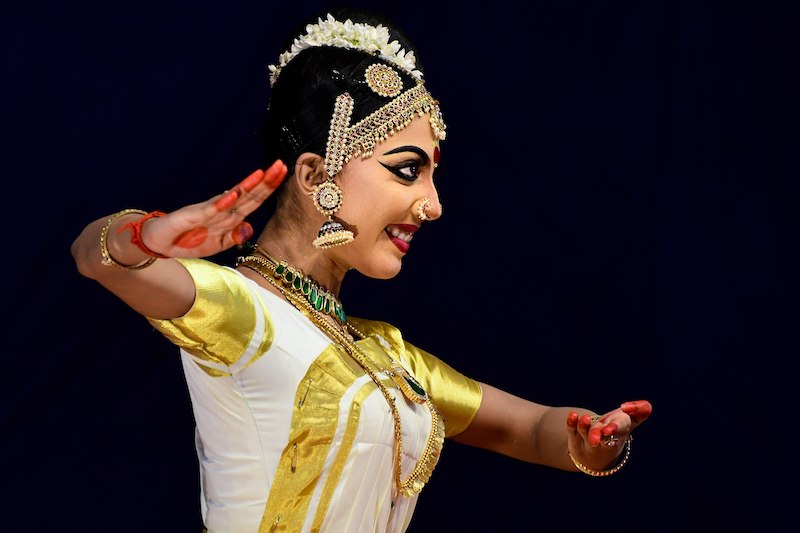
Jatisvaram: Rhythmic Exploration
Following the invocation, the performance transitions into Jatisvaram, a segment focused on rhythmic exploration and improvisation. Dancers showcase their mastery of intricate footwork and rhythmic patterns, synchronizing their movements with the accompanying percussion instruments. Jatisvaram allows for artistic expression within the framework of established rhythmic structures, highlighting the dancer’s agility and precision.
Varnam: Narrative and Expression
Varnam is the centerpiece of a Mohiniyattam recital, combining narrative storytelling with expressive dance sequences. Dancers portray characters from mythology, folklore, or literature, weaving together themes of love, devotion, and heroism. Through emotive abhinaya, they evoke the essence of the narrative, conveying a range of emotions and sentiments to captivate the audience. Varnam represents the culmination of artistic skill and dramatic interpretation in Mohiniyattam performances.
Padam: Emotional Depth
In the Padam segment, dancers delve into deeper emotional themes, exploring the nuances of love, longing, and introspection. Through poignant gestures and soulful expressions, they convey the depth of human experience, touching the hearts of the audience. Padam showcases the dancer’s ability to evoke empathy and connect on a profound emotional level, leaving a lasting impression on the spectators.
Tillana: Celebration and Joy
The Tillana marks the culmination of the Mohiniyattam recital, characterized by its festive and celebratory mood. Dancers exhibit exuberant movements and energetic footwork, expressing joy and vitality through their performance. Tillana serves as a vibrant finale, leaving the audience uplifted and invigorated by the dynamic display of skill and artistry.
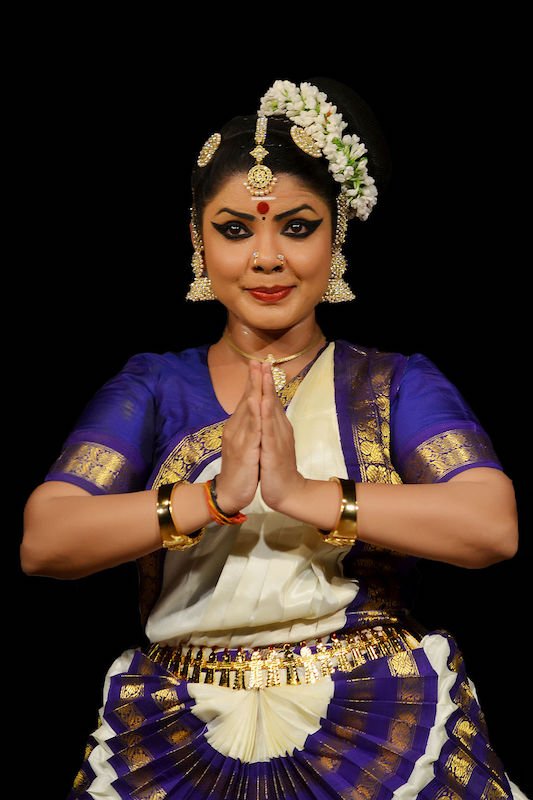
Shlokam and Saptam: Concluding Reverence
To conclude the performance, dancers often recite shlokas or verses from sacred texts, offering prayers and invoking blessings for auspiciousness and prosperity. The Saptam segment may include additional dance sequences or expressions of gratitude, providing a fitting conclusion to the Mohiniyattam recital. Through these final offerings, dancers express reverence and gratitude, honouring the spiritual and artistic dimensions of the dance tradition.
Conclusion
Mohiniyattam stands as a testament to the beauty, diversity, and resilience of India’s cultural heritage. From its ancient origins to its contemporary expressions, this classical dance form embodies the spirit of creativity, tradition, and innovation, captivating hearts and minds around the world. As we celebrate Mohiniyattam’s legacy and cultural significance, we are reminded of the power of art to transcend boundaries, unite communities, and inspire positive change.





